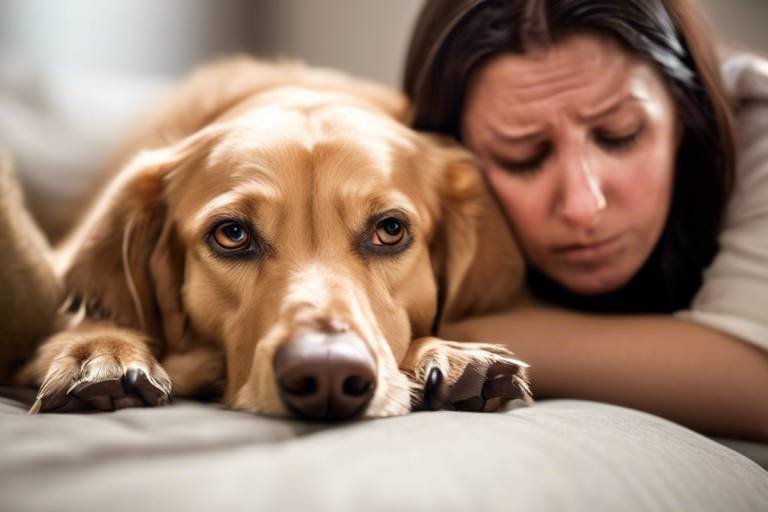Tips for Keeping Your Pet Safe During Outdoor Activities
Taking your furry friend on outdoor adventures can be one of the most rewarding experiences for both of you. However, just like any great adventure, it's essential to prepare adequately to ensure your pet's safety. Whether you're hiking through a dense forest, splashing around at the beach, or simply enjoying a sunny day at the park, there are several key considerations to keep in mind. In this article, we will explore various tips and guidelines that will help you keep your pet safe while enjoying the great outdoors. After all, nothing spoils a fun day out like an unexpected mishap!
First things first, selecting the appropriate gear for your pet is crucial for their safety and comfort during outdoor activities. Think of it as equipping your pet with their own adventure toolkit. A good leash and harness are essential, especially if your pet tends to wander off or get easily distracted. Harnesses can be more comfortable for your pet and provide better control than traditional collars. Additionally, consider investing in reflective gear if you're planning on being out during dusk or dawn. This not only keeps your pet visible but also gives you peace of mind.
Just like us, pets need to stay hydrated and well-nourished, especially during physical activities. When planning your outdoor excursion, pack enough water and food to keep your furry friend energized. A collapsible water bowl is a great addition to your gear; it’s lightweight and easy to carry. Remember to offer water to your pet regularly, especially on hot days. If your outing is lengthy, consider packing high-energy snacks that are easy on the stomach and provide a quick boost. Your pet will thank you for it!
Weather can significantly impact your pet's safety and enjoyment during outdoor activities. Before heading out, check the forecast and be prepared for any changes. If it’s a hot day, avoid strenuous activities during peak sun hours, usually between 10 AM and 4 PM. On the flip side, cold weather can also pose risks, especially for smaller breeds or those with short coats. Make sure to dress your pet appropriately, and keep an eye on them for signs of discomfort. Rainy days might seem like a washout, but with the right gear, you can still enjoy a fun outing—just be cautious of slippery surfaces!
Outdoor environments can present various hazards for pets. From toxic plants to wildlife encounters, being aware of your surroundings is crucial. Some common dangers to watch for include:
- Toxic plants: Many plants can be harmful if ingested, such as lilies, azaleas, and sago palms.
- Wildlife encounters: Be cautious of snakes, insects, and other animals that might pose a threat.
- Difficult terrain: Sharp rocks, steep slopes, and water hazards can lead to injuries.
Always keep your eyes peeled and be proactive in ensuring your pet’s safety during your adventures.
Accidents can happen, and being prepared for emergencies is key to keeping your pet safe. It’s wise to carry a basic first aid kit specifically for pets. This should include items like antiseptic wipes, bandages, tweezers, and any medications your pet may need. Familiarize yourself with basic first aid techniques, so you can act quickly in case of minor injuries. Remember, a little preparation can go a long way in ensuring your pet's well-being during your outdoor escapades!
Proper training and socialization are paramount for your pet's behavior in outdoor settings. Before embarking on adventures, ensure your pet is well-trained to respond to commands. This is particularly important when encountering other animals or people. Socialization helps your pet feel comfortable and confident in various environments. Consider taking your pet to dog parks or enrolling them in training classes to improve their social skills. A well-trained pet is not only safer but also more enjoyable to be around!
Maintaining control over your pet is crucial in outdoor environments. Always keep your pet on a leash unless you are in a designated off-leash area. This not only prevents them from running off but also protects them from potential dangers. Use a long leash for more freedom while still keeping them under control. Regularly check in with your pet, especially if they seem distracted or curious about their surroundings. Remember, being proactive is the best way to prevent accidents!
After your outdoor adventures, it’s important to check your pet for any signs of distress or injury. Look for any cuts, scrapes, or unusual behaviors that might indicate discomfort. Ensure they are hydrated and offer them a light meal if it’s been a long day. A gentle brushing can help remove any debris or ticks that may have found their way onto your pet during your outing. By taking these simple steps, you can ensure your pet remains healthy and happy after a day of fun!
Traveling with pets requires additional safety measures. Whether you’re going on a road trip or taking a flight, it's essential to keep your pet secure and comfortable. Use a pet seatbelt or a secured crate in the car to prevent distractions. Make frequent stops during long drives to let your pet stretch and relieve themselves. If flying, check the airline's pet policies and prepare your pet for the journey ahead. With the right preparations, traveling can be a breeze!
Q: How can I tell if my pet is overheating?
A: Signs of overheating include excessive panting, drooling, weakness, and lethargy. If you notice these symptoms, move your pet to a cooler area and provide water immediately.
Q: What should I do if my pet encounters wildlife?
A: Keep your distance and do not attempt to approach or interact with wild animals. If your pet seems overly curious, call them back to you and redirect their attention.
Q: Are there specific foods I should avoid packing for my pet?
A: Yes, avoid packing foods that are high in sugar, fat, or that are toxic to pets, such as chocolate, grapes, and onions.

Choosing the Right Gear
When it comes to outdoor adventures with your furry friend, is not just a matter of convenience; it's a matter of safety and comfort. Imagine heading out for a hike with your pet, only to realize that their leash is frayed or their harness is too loose. Not only could this lead to an escape, but it might also make your pet uncomfortable. To avoid such scenarios, it's essential to invest in high-quality gear that fits properly and is suitable for your outdoor activities.
First, let’s talk about leashes and harnesses. A sturdy leash is your pet’s lifeline during outdoor excursions, especially in areas where they might encounter other animals or people. Opt for a durable leash that can withstand pulling and unexpected tugs. Additionally, a well-fitted harness is crucial, especially for dogs that tend to pull. Unlike collars, harnesses distribute pressure across the chest and back, minimizing the risk of injury to your pet's neck. When selecting a harness, ensure it’s adjustable and fits snugly without being too tight.
Next up, consider the weather conditions. If you’re heading out on a sunny day, a lightweight, breathable harness will keep your pet cool. On the flip side, if it’s chilly, you might want to invest in a cozy dog jacket. Remember, pets can get cold just like we do, so a warm layer can make all the difference. For rainy days, a waterproof coat can keep your pet dry and comfortable, allowing them to enjoy the outdoors without the discomfort of wet fur.
Additionally, don’t forget about protective gear. For example, booties can protect your pet's paws from hot pavement, sharp rocks, or even icy surfaces. These little accessories can prevent injuries and keep your pet safe from harmful elements. When selecting booties, look for ones that provide a good grip and are easy to put on and take off.
Finally, consider carrying a pet first aid kit with you. It’s always better to be prepared for the unexpected. A basic kit should include items like antiseptic wipes, bandages, tweezers for removing splinters, and any specific medications your pet may need. You can easily find pre-made kits at pet stores or online, or you can assemble your own based on your pet's needs.
In summary, choosing the right gear for your pet isn’t just about style; it’s about ensuring their safety, comfort, and happiness during outdoor adventures. By investing in quality leashes, harnesses, weather-appropriate clothing, protective gear, and a first aid kit, you can make your outings enjoyable for both you and your furry companion.

Hydration and Nutrition
When it comes to outdoor adventures with your furry friend, hydration and nutrition are two of the most important aspects to consider. Just like us, pets need to stay hydrated, especially when they're active and exposed to the elements. Imagine hiking up a steep trail or playing fetch at the beach; your pet is likely to expend a lot of energy, and without adequate hydration, they could quickly become exhausted or overheated. So, how do you ensure your pet is getting enough water and the right nutrients during these outings? Let’s dive in!
First and foremost, always carry enough fresh water for both you and your pet. A good rule of thumb is to bring at least one ounce of water per pound of your pet's body weight for every hour of activity. This means if you have a 20-pound dog, you should aim for at least 20 ounces of water for a couple of hours of play. To make this easier, consider using a portable pet water bottle or collapsible bowl. These are not only convenient but also help prevent spills and messes.
In addition to hydration, keeping your pet well-nourished is essential. Pack some of their favorite snacks or meals that are easy to carry and serve. Look for high-energy treats that can provide a quick boost when your pet needs it. Here’s a quick list of great options:
- High-protein dog treats
- Dehydrated fruits or vegetables
- Peanut butter-filled kongs
- Energy bars specifically designed for pets
It's also wise to consider the timing of meals. If you plan on a long hike, try to feed your pet a few hours before you set out. A full stomach can lead to discomfort during vigorous activity. On the flip side, avoid letting them eat immediately after exercise; their digestive system needs time to settle before you introduce food.
Lastly, always be aware of your pet's unique dietary needs. Some pets may have allergies or sensitivities that require special attention. For instance, if your dog is allergic to certain proteins, be sure to avoid giving them treats that contain those ingredients. Always read labels and opt for foods that are high in quality and suited to your pet's specific health requirements.
In summary, keeping your pet hydrated and well-nourished during outdoor activities is not just a good idea; it's a necessity for their health and happiness. By planning ahead and being mindful of their needs, you can ensure that your adventures are enjoyable for both you and your furry companion.

Weather Considerations
When it comes to enjoying outdoor activities with your beloved pet, play a pivotal role in ensuring their safety and comfort. Imagine planning a fun day at the beach only to realize the sun is blazing down, or heading out for a hike in the woods when a sudden storm rolls in. These scenarios can turn a delightful adventure into a stressful situation for both you and your furry friend. Therefore, being aware of the weather conditions beforehand can make all the difference.
First and foremost, heat can be a silent enemy for pets, especially dogs. Their bodies do not cool off as efficiently as ours do, making them prone to overheating. On hot days, it’s essential to keep an eye on the temperature and humidity levels. If it’s too hot for you, it’s likely too hot for your pet. Look for signs of heat exhaustion, such as excessive panting, drooling, or lethargy. To keep your pet cool, ensure they have access to plenty of fresh water, and consider scheduling outdoor activities for the cooler parts of the day, like early morning or late evening.
On the flip side, cold weather can also pose risks to your pet’s health. Just like us, pets can suffer from frostbite and hypothermia. Breeds with short coats or small sizes are especially vulnerable. If you’re planning to take your pet out when temperatures drop, make sure they’re dressed appropriately. Dog sweaters and booties can help protect them from the cold ground and chilly air. Watch for signs of discomfort, such as shivering or reluctance to move, which can indicate that it’s time to head back indoors.
Rainy weather brings its own set of challenges. Wet conditions can lead to slippery surfaces, increasing the risk of falls and injuries. Moreover, some pets may be hesitant or fearful of storms, making it crucial to assess their comfort level before venturing out. If rain is in the forecast, consider using a waterproof coat for your pet to keep them dry and warm. Make sure to dry them off thoroughly once you’re back home to prevent any chills.
To help you plan your outdoor activities better, here’s a simple weather checklist to remember:
| Weather Condition | Precautions |
|---|---|
| Hot Weather | Provide plenty of water, avoid peak sun hours, and watch for signs of overheating. |
| Cold Weather | Dress your pet in warm clothing, limit exposure time, and monitor for signs of distress. |
| Rainy Weather | Use a waterproof coat, avoid slippery areas, and dry off your pet afterward. |
In conclusion, keeping an eye on the weather is not just a good idea; it’s a necessity when planning outdoor adventures with your pet. By taking the time to prepare for the elements, you can ensure that both you and your furry friend have a safe and enjoyable experience, regardless of what nature throws your way.
Q: How can I tell if my pet is too hot or too cold?
A: Look for signs such as excessive panting, drooling, or lethargy in hot weather, and shivering or reluctance to move in cold weather.
Q: What should I do if my pet gets overheated?
A: Move them to a cooler area, provide water, and use a damp cloth to help lower their body temperature.
Q: Are there specific breeds that are more sensitive to temperature changes?
A: Yes, smaller breeds and those with short coats tend to be more sensitive to cold, while brachycephalic breeds (like Bulldogs) can struggle in the heat.
Q: Is it safe to walk my dog in the rain?
A: Yes, but make sure they are comfortable with the rain and use protective gear to keep them dry.

Identifying Hazards
When you're out enjoying the great outdoors with your furry friend, it can be easy to get caught up in the excitement of the moment. However, it's crucial to remain vigilant and identify potential hazards that could pose risks to your pet's safety. Just like a treasure hunt, you should be on the lookout for hidden dangers that may not be immediately obvious but could lead to trouble.
One of the most common hazards in outdoor environments is toxic plants. Many plants that grow in the wild can be harmful or even deadly to pets. For instance, plants like oleander, foxglove, and lily of the valley can cause serious health issues if ingested. It's wise to familiarize yourself with local flora and have a basic understanding of which plants to avoid. Consider creating a small reference guide or using a plant identification app to help you on your adventures.
Another potential danger comes from wildlife encounters. While your pet may be curious and eager to meet new animal friends, not all wildlife is friendly. Animals such as raccoons, skunks, and even deer can be unpredictable. It's essential to keep your pet on a leash and under control, especially in areas where wildlife is known to roam. This not only protects your pet but also helps maintain the natural balance of the ecosystem.
Additionally, the terrain itself can present challenges. Rocky paths, steep inclines, and slippery surfaces can be treacherous for pets that aren’t accustomed to such conditions. Always assess the trail before you embark on your journey. If you notice areas that seem hazardous, consider finding an alternative route or using protective gear for your pet, such as booties designed to shield their paws from rough surfaces.
Here’s a quick summary of some common hazards to watch out for during outdoor activities:
- Toxic Plants: Familiarize yourself with plants that can be harmful.
- Wildlife Encounters: Keep your pet leashed and supervised around wildlife.
- Difficult Terrain: Assess the path before proceeding and consider protective gear.
Lastly, don’t forget about the weather! Extreme temperatures can pose significant risks as well. Hot pavement can burn your pet's paws, while cold conditions can lead to hypothermia. Always check the weather forecast and plan accordingly, adjusting your activities to ensure your pet's comfort and safety.
By being aware of these hazards and taking proactive steps to mitigate them, you can enjoy your outdoor adventures with peace of mind. Remember, your pet relies on you to keep them safe, so stay alert and prepared for whatever nature throws your way!
Q: What should I do if my pet ingests a toxic plant?
A: If you suspect your pet has ingested a toxic plant, contact your veterinarian or an emergency animal poison control hotline immediately. Time is of the essence in such situations.
Q: How can I train my pet to avoid wildlife?
A: Training your pet to respond to commands like 'leave it' or 'come' can help keep them away from wildlife. Regular socialization and exposure to different environments can also improve their behavior in the wild.
Q: What are the signs of overheating in pets?
A: Signs of overheating include excessive panting, drooling, weakness, and difficulty breathing. If you notice these symptoms, move your pet to a cooler area and provide water immediately.

First Aid Preparedness
When it comes to outdoor activities with your beloved pet, being prepared for emergencies is not just a good idea—it's essential. Imagine you're hiking up a beautiful mountain trail, the sun is shining, and your furry friend is having the time of their life. Suddenly, they trip and hurt their paw. What do you do? This is where comes into play. Having a well-stocked first aid kit specifically for your pet can make all the difference in those unexpected moments.
First, let's talk about what should be included in your pet's first aid kit. You wouldn't head out on a road trip without snacks and drinks, right? Similarly, your pet deserves to have their own safety supplies. Here’s a quick rundown of essential items that should be in your kit:
- Adhesive bandages - For minor cuts and scrapes.
- Antiseptic wipes - To clean wounds and prevent infection.
- Gauze pads and tape - For wrapping larger injuries.
- Hydrogen peroxide - Useful for inducing vomiting in certain situations, but consult your vet first.
- Tweezers - Great for removing splinters or ticks.
- Emergency contact numbers - Keep a list of your vet and the nearest animal hospital.
Now, just having these supplies isn't enough; knowing how to use them is equally important. For example, if your pet gets a cut, you need to know how to properly clean it and apply a bandage. It’s worth taking a pet first aid class to familiarize yourself with these skills. Think of it as a life jacket for your pet—it's not just about having it, but also knowing how to use it if things go south.
In addition to your first aid supplies, it's wise to carry a pet-specific first aid manual. This guide can provide step-by-step instructions for various situations you might encounter while out and about. You never know when you might need to reference it, and having that information at your fingertips can ease your mind in a stressful situation.
Don't forget to regularly check your first aid kit! Just like you wouldn’t want to find out your favorite snack has expired on a road trip, you don’t want to discover that your antiseptic wipes are outdated when you really need them. Make it a habit to inspect your kit every few months and replace any used or expired items.
To wrap it all up, being prepared for emergencies during outdoor activities with your pet is all about having the right supplies and knowledge at your disposal. By investing a little time in preparation, you can enjoy your adventures with peace of mind, knowing that you're ready for whatever comes your way. Just remember, the goal is to keep your furry friend safe and sound while you both enjoy the great outdoors!
Q1: What should I do if my pet gets injured while hiking?
A1: First, assess the injury. If it's minor, clean it with antiseptic and bandage it. If it's severe, contact your veterinarian immediately. Always have your first aid kit handy!
Q2: How often should I check my pet's first aid kit?
A2: It's a good practice to check your kit every few months. Replace any expired items and restock supplies that have been used.
Q3: Can I use human first aid supplies on my pet?
A3: Some human supplies can be used, but it's best to have pet-specific items. For example, certain antiseptics can be harmful to pets, so always consult your vet for guidance.

Training and Socialization
When it comes to enjoying outdoor adventures with your pet, training and socialization are absolutely crucial. Think of it this way: just like we need to learn the rules of the road before driving, our furry friends need to understand how to behave in various environments. Whether it's a bustling park filled with other dogs or a serene hiking trail, proper training ensures your pet can navigate these situations safely and confidently.
Socialization is all about exposing your pet to different experiences, people, and animals in a controlled manner. This helps them become well-adjusted and reduces the likelihood of fear or aggression in new situations. For instance, if your dog is used to seeing other dogs during walks, they are less likely to react negatively when they encounter a new canine companion on the trail. Start young if possible; puppies are like sponges, soaking up everything around them. However, it's never too late to socialize an older pet! Just be patient and consistent.
Training should include basic commands such as sit, stay, come, and leave it. These commands can be lifesavers during your outdoor excursions. Imagine your dog spotting a squirrel and taking off! If they respond to the command come, you can call them back before they get into trouble. It’s not just about obedience; it’s about keeping them safe and ensuring a stress-free experience for both of you.
Consider enrolling your pet in a training class, especially if you’re new to pet ownership. Professional trainers can provide valuable techniques and insights that you might not have thought of. Plus, attending classes is a great way to socialize your pet with other animals and people in a controlled environment. Alternatively, you can set up playdates with friends who have pets. Just remember to supervise these interactions to ensure they go smoothly.
In addition to formal training, you can practice commands and socialization techniques during your outdoor activities. For example, when you’re at a park, practice stay while you throw a ball for another dog. This not only reinforces their training but also helps them learn how to focus amidst distractions. Always reward positive behavior with treats or praise — this builds a strong bond and encourages them to repeat those good behaviors.
Lastly, keep in mind that socialization is an ongoing process. Regularly exposing your pet to new experiences, environments, and people will help maintain their social skills and adaptability. Think of it as a lifelong learning journey for your furry companion. The more experiences they have, the more confident and well-rounded they will become, making your outdoor adventures even more enjoyable.
- How early should I start socializing my puppy? It's best to start socializing your puppy as early as 3-14 weeks of age when they are most receptive to new experiences.
- What if my dog is fearful of other animals? Gradually introduce them to calm and friendly animals in a controlled environment, using positive reinforcement to encourage good behavior.
- How can I train my dog to come when called? Use treats and a happy tone to encourage them to come to you. Practice in a safe, enclosed area before moving to more distracting environments.

Supervision and Control
When you're out enjoying the great outdoors with your furry companion, are paramount. Imagine this: you’re hiking up a beautiful mountain trail, surrounded by stunning views and the sounds of nature. Suddenly, your pet spots a squirrel and dashes off into the bushes. In a matter of seconds, your peaceful hike turns into a frantic search. To avoid such scenarios, maintaining control over your pet is essential.
First and foremost, using a proper leash is a game-changer. A sturdy, comfortable leash not only keeps your pet close but also gives you peace of mind. Opt for a leash that’s appropriate for your pet's size and strength. For larger dogs, a heavier-duty leash is advisable, while a lighter one suffices for smaller breeds. Additionally, consider using a harness instead of a collar. Harnesses distribute pressure across your pet's body, reducing the risk of injury and giving you better control.
But what about those moments when you want to give your pet a little freedom? This is where a long line comes into play. A long line allows your pet to explore while still being under your control. It’s a great middle ground between complete freedom and total restriction. Just be sure to monitor your pet closely, especially in areas with potential hazards.
It’s also important to be aware of your surroundings. Look out for other animals, people, and any potential dangers that could arise. If you’re in an area with lots of wildlife, it's best to keep your pet on a short leash. This not only helps in preventing them from chasing after wild animals but also keeps them safe from possible encounters with snakes or other dangerous creatures.
Another aspect of supervision is understanding your pet's behavior. Some pets are naturally more curious or excitable than others. Take time to observe how your pet reacts to different situations. For instance, if your dog tends to be anxious around other dogs, it may be best to keep a safe distance or avoid busy areas altogether. This not only protects your pet but also helps in maintaining a calm environment for everyone involved.
Finally, consider investing in a GPS collar or tracker for your pet. These devices can be lifesavers if your pet manages to slip away from you. With real-time tracking, you can quickly locate your furry friend, reducing the stress and worry that comes with losing sight of them.
In summary, keeping your pet under supervision and control during outdoor activities is crucial for their safety and your peace of mind. By using the right gear, being aware of your surroundings, and understanding your pet's behavior, you can create a safe and enjoyable experience for both of you. Remember, the goal is to have fun while ensuring that your beloved pet remains safe and secure!
- What type of leash is best for my pet? A sturdy leash that fits your pet's size and strength is ideal. Consider a harness for better control.
- How can I keep my pet from wandering off? Use a long line for exploration while maintaining control, and always keep an eye on your surroundings.
- Should I use a GPS collar? Yes, a GPS collar can help you quickly locate your pet if they get lost.
- What should I do if my pet encounters wildlife? Keep your pet on a short leash and maintain a safe distance to avoid potential dangers.

Post-Activity Care
After a day filled with excitement and adventure, it's easy to overlook the importance of for your furry friend. Just as we need to unwind and recuperate after a long day, our pets do too. This phase is crucial in ensuring that your pet remains healthy and happy following your outdoor escapades. So, what should you do once the fun is over? Let's dive into some essential steps!
First and foremost, always perform a thorough check-up on your pet. Look for any signs of distress, injuries, or irritations that might have gone unnoticed during your activities. Examine their paws for cuts or abrasions, especially if you’ve been hiking on rocky trails or sandy beaches. It's not just about the obvious; sometimes, small stones or thorns can lodge between their pads, causing discomfort later on.
Next, make sure to hydrate your pet. Just like humans, pets can become dehydrated after a long day outdoors. Offer them fresh water right away, and if your adventure involved a lot of physical activity, consider adding some electrolytes to their water. This can help replenish lost minerals and keep them feeling their best. If you're unsure about how to do this, consult your veterinarian for recommendations.
Another important aspect of post-activity care is nutrition. After burning all that energy, your pet deserves a nutritious meal. Choose high-quality food that meets their dietary needs and consider adding in a few treats. Remember, though, not to overfeed them right after an adventure; give them time to digest before diving into a big meal.
While you're checking your pet over, don’t forget to inspect their gear. Look for any signs of wear and tear on their leash, harness, or collar. A broken or damaged piece of equipment can pose a significant risk during your next outing. Keeping their gear in top shape is just as important as ensuring their well-being.
Lastly, take a moment to give your pet some affection. After a day of fun, they love to feel your love and appreciation. A gentle rub behind the ears or a cuddle session can go a long way in reinforcing the bond you share. It’s also a great time to reflect on the day’s adventures and start planning your next outing together!
- How often should I check my pet after outdoor activities? It's best to check your pet immediately after returning home and then again the following day to ensure they are still feeling well.
- What signs should I look for to indicate my pet is unwell? Look for excessive panting, limping, reluctance to walk, or any unusual behavior. If you notice anything concerning, consult your veterinarian.
- Can I give my pet human food as a reward after an outing? Some human foods are safe for pets, but always check with your vet first. Avoid foods that are toxic to pets, such as chocolate, grapes, and onions.

Traveling with Pets
Traveling with your furry friend can be one of the most rewarding experiences for both of you, but it also comes with its own set of challenges. Whether you're heading out on a weekend road trip or a longer journey, keeping your pet safe and comfortable is paramount. Just like you wouldn’t hit the road without your seatbelt, your pet deserves the same level of care and preparation. So, how do you ensure a smooth ride for your beloved companion? Let's dive into some essential tips!
First and foremost, always make sure your pet is secured in the vehicle. This can be done using a pet seatbelt, a carrier, or a travel crate. Not only does this keep them safe in case of sudden stops, but it also prevents them from distracting the driver. Imagine trying to navigate through traffic while your dog is bouncing around the back seat! A good rule of thumb is to keep them in the back seat, as airbags can be dangerous for pets in the front.
Next, consider your pet's comfort during the journey. Just like you would pack snacks and drinks for yourself, your pet also needs their essentials. Make sure to bring along their favorite food, water, and a portable bowl. It’s a good idea to pack some treats as well, as they can serve as a great motivator for good behavior during the trip. When planning your route, try to include regular stops to give your pet a chance to stretch their legs and relieve themselves. Think of it as a mini adventure for them!
Another important aspect of traveling with pets is being mindful of the weather. If it's a hot day, never leave your pet alone in a parked car, even for a few minutes. The temperature inside a vehicle can rise to dangerous levels in a matter of minutes, potentially leading to heatstroke. Instead, plan your travel times around cooler parts of the day. If you're traveling in winter, ensure your pet is warm enough and consider protective gear like dog sweaters or booties if necessary.
It's also crucial to have a pet-friendly travel kit ready. This kit should include:
- Water and collapsible bowl
- Pet food and snacks
- Leash and harness
- Waste bags for clean-up
- First aid supplies
- Any medications your pet may need
Having these items on hand can make your travels much smoother and more enjoyable. Plus, it ensures that you’re prepared for any situation that may arise.
Lastly, don't forget to keep your pet's identification up to date. Ensure they wear a collar with an ID tag that includes your contact information. In case you get separated, a microchip can also provide an extra layer of security. It’s like having a safety net for your pet, just in case they decide to go on their own little adventure!
In summary, traveling with pets can be a delightful experience filled with memories. By taking the time to prepare and plan ahead, you can ensure that every journey is safe and enjoyable for both you and your furry companion. So, pack your bags, grab the leash, and hit the road—adventure awaits!
| Question | Answer |
|---|---|
| Can I take my pet on a plane? | Yes, but check with the airline for their specific pet policies. Some airlines allow pets in the cabin, while others may require them to travel in the cargo hold. |
| What should I do if my pet gets car sick? | Consult your veterinarian for advice. They may recommend medication or tips to help your pet feel more comfortable during travel. |
| Are there pet-friendly hotels? | Many hotels now offer pet-friendly accommodations. Always call ahead to confirm their policies and any additional fees. |
Frequently Asked Questions
- What gear should I use for my pet during outdoor activities?
Choosing the right gear is essential for your pet's safety and comfort. Look for durable leashes and harnesses that fit well. Consider items like reflective vests for visibility, and portable water bowls to keep your pet hydrated on the go.
- How can I ensure my pet stays hydrated during outdoor adventures?
Always pack enough water for your pet, especially on hot days. A good rule of thumb is to provide water every 30 minutes of activity. You can also bring along pet-friendly snacks to keep their energy levels up!
- What should I do if the weather is too hot or too cold for my pet?
Be mindful of temperature extremes. In hot weather, plan outings during cooler parts of the day and provide shade and water. In cold conditions, consider dog jackets or booties to protect against frostbite and keep them warm.
- What hazards should I be aware of while outdoors with my pet?
Watch out for toxic plants, sharp objects, and wildlife encounters. It's also important to be cautious of difficult terrain that could lead to injuries. Keeping your pet on a leash can help avoid many of these dangers.
- How can I prepare for a pet emergency while outdoors?
Always carry a basic first aid kit that includes bandages, antiseptic wipes, and any necessary medications. Familiarize yourself with common pet injuries and how to treat them. Being prepared can make all the difference in an emergency!
- What type of training does my pet need for outdoor activities?
Basic obedience training is crucial. Your pet should respond to commands like "come," "stay," and "leave it." Socialization with other animals and people will also help them behave better in public spaces.
- How can I keep my pet under control during outdoor outings?
Use a sturdy leash and harness, and practice recall commands. Keeping your pet close and attentive is key, especially in busy or unfamiliar environments. Regular training sessions can greatly improve their behavior.
- What should I do after an outdoor activity with my pet?
After your adventure, check your pet for any signs of distress, injuries, or ticks. Make sure they are hydrated and provide a comfortable space for them to rest. Regular post-activity checks can help catch any issues early!
- What are the best practices for traveling with pets?
Ensure your pet is secure in the vehicle, using a pet seatbelt or carrier. Take regular breaks during long trips for bathroom and exercise needs. Always have water and snacks handy to keep them comfortable during the journey.



















